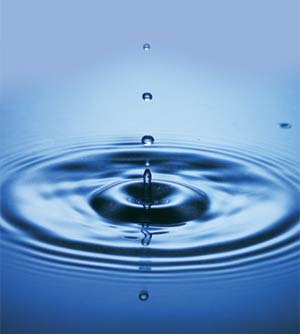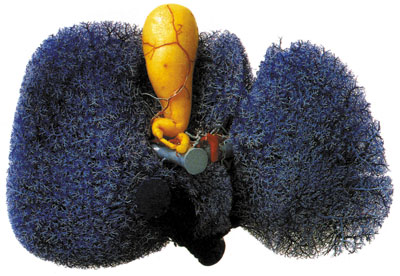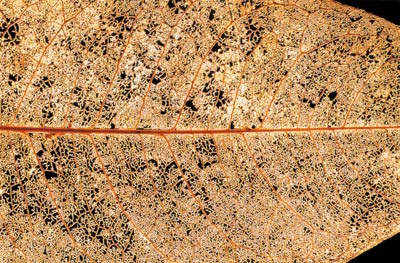This, as most other of the Atheists' Arguments, proceeds from a deep Ignorance of Natural Philosophy; for if there were but half the sea that now is, there would also be but half the Quantity of Vapours, and consequently we could have but half as many Rivers as now there are to supply all the dry land we have at present, and half as much more; for the quantity of Vapours which are raised, as well as to the heat which raised them. The Wise Creator therefore did so prudently order it, that the seas should be large enough to supply Vapours sufficient for all the land John Ray, 18th century British Naturalist 76
 |
Most of our planet is covered with water. Oceans and seas make up three fourths of the Earth's surface while the land itself contains countless numbers of rivers and lakes. The snow and ice on the summits of lofty mountains is water in its frozen form. A substantial part of the Earth's water is in the sky: every cloud contains thousands–sometimes millions–of tons of water in the form of vapor. From time to time some of this water vapor turns into drops of liquid and falls to the ground: in other words, it rains. Even the air you're breathing now contains a certain amount of water vapor.
In short, no matter where you may look on the surface of the Earth, you're certain to see water around somewhere. Indeed, the room you're sitting in at this moment probably contains about forty to fifty liters of water in it. Look around. You can't see it? Look again, more carefully, this time raising your eyes from these words and look at your hands, arms, legs, and body. That 40-50 liter mass of water is you!
It's you because about 70% of the human body is water. Your body's cells contain many things but nothing so much as water. The biggest part of the blood that circulates everywhere in your body is of course water. This is true not just of yourself or of other people however: the bulk of the bodies of all living things is water. Without water it seems, life is impossible.
Water is a substance that was specially created so as to be the basis of life. Each and every one of its physical and chemical properties was specially created for life.
The biochemist A. E. Needham notes how essential liquids are for life to form in his book The Uniqueness of Biological Materials. If the laws of the universe had allowed only solids or gases to exist, there never would have been any life. The reason is that the atoms of solids are too tightly-packed and static and simply will not allow the dynamic molecular processes that are necessary for life to take place. In gases, on the other hand, the atoms move about freely and chaotically: it would be impossible for the complex mechanisms of life-forms to function within such a structure.
In short, the existence of a liquid environment is essential in order for the processes necessary for life to take place. The most ideal of all liquids–or rather, the only ideal liquid–for this purpose is water.
 |
That water possesses properties that are extraordinarily fit for life is something that drew the attention of scientists long ago. The first attempt to investigate this subject in detail however was Astronomy and General Physics Considered with Reference to Natural Theology, a book by the English naturalist William Whewell that was published in 1832. Whewell had been examining the thermal properties of water and noticed that some of them seemed to violate the accepted rules of natural law. The conclusion he drew from this was that these inconsistencies should be taken as proof that this substance had been specially created in order for life to exist.
The most comprehensive analysis of the suitability of water for life was to come from Lawrence Henderson, a professor in the Department of Biological Chemistry of Harvard University, about a century after Whewell's book. In his book The Fitness of the Environment, which some were later to call "the most important scientific work of the first quarter of the 20th century", Henderson reaches this conclusion concerning the natural environment of our world:
The fitness…(of these compounds constitutes) a series of maxima–unique or nearly unique properties of water, carbon dioxide, the compounds of carbon, hydrogen, and oxygen and the ocean–so numerous, so varied, so complete among all things which are concerned in the problem that together they form certainly the greatest possible fitness.77
One of the subjects dealt with in Henderson's book is the thermal properties of water. Henderson notes that there are five distinct ways in which the thermal properties of water are unusual:
All known solids decrease in size as they grow colder. This is true of all known liquids as well: as their temperatures decrease, they lose volume. As volume decreases, density increases and thus the colder parts of the liquid become heavier. This is why the solid forms of substances weigh more (by volume) than they when they are in liquid form. There is one case where this "law" is violated: water. Like other liquids, water contracts in volume as it grows colder but it only does this down to a certain temperature (4°C) thereafter–unlike all other known liquids–it suddenly begins to expand and when it finally solidifies (freezes) it expands even more. As a result, "solid water" is lighter than "liquid water". According to the normal laws of physics, solid water, which is to say ice, ought to be heavier than liquid water and should sink to the bottom when it forms; instead, it floats.
By now you are probably wondering what importance these seemingly technical five physical properties could possibly have. As it turns out, the significance of each and every one of them is enormous because life in general and our own life in particular is possible in this world just because these five properties are what they are.
Let's now take a look at them one by one.
Other liquids freeze from the bottom up; water freezes from the top down. This is the first unusual property of water mentioned above and it is crucial for the existence of water on the surface of the Earth. Were it not for this property, that is, if ice didn't float, much of our planet's water would be locked up in ice and life would be impossible in its seas, lakes, ponds, and rivers.
Let's examine this in detail to see why. There are many places in the world where the temperature falls below 0°C in winter, often considerably below that. Such cold will of course affect the water in seas, lakes, etc. These bodies of water grow colder and colder and parts of them begin to freeze. If ice didn't behave the way it does (if it didn't float in other words) this ice would sink to the bottom while the warmer bits of water would rise to the surface and be exposed to the air. But the temperature of that air is still below freezing so these will freeze too and sink to the bottom. This process would continue until there was no liquid water left at all. But this isn't what happens. What happens instead is this: As it gets colder, water grows heavier until it reaches 4°C at which point everything suddenly changes. After this, the water begins to expand and it becomes lighter as the temperature drops. As a result, the 4°C water remains on the bottom, the 3°C water above it, the 2°C water above that and so on. Only at the surface does the temperature of the water actually reach 0°C and there it freezes. But only the surface has frozen: the 4°C layer of water beneath the ice remains liquid and that is enough for underwater creatures and plants to continue to live.
 |
| Unlike all other liquids, water expands when it freezes. Because of this, ice floats in water. |
(We should note here that the fifth property of water–the low thermal conductivity of ice and snow–is also crucial in this process. Because they are such poor conductors of heat, the layers of ice and snow keep the heat in the water below from escaping into the atmosphere. As a result of all this, even if the air temperature falls to –50°C, the layer of sea ice will never be more than a meter or two thick and there will be many fractures in it. Creatures such as seals and penguins that dwell in polar regions can take advantage of this to reach the water beneath the ice.)
Again let us recall what would happen if water didn't behave this way and acted "normally" instead. Suppose water continued to become denser the lower its temperature became like all other liquids and ice sank to the bottom. What then?
Well in that case, the freezing process in the oceans and seas would start from the bottom and continue all the way to the top because there would be no layer of ice on the surface to prevent the remaining heat from escaping. In other words, most of earth's lakes, seas, and oceans would become solid ice with a layer of water perhaps a few meters deep on top of it. Even when the air temperature increased, the ice at the bottom would never melt completely. In the seas of such a world, no life could exist and in an ecological system with dead seas, life on land would also be impossible. In other words, if water didn't "misbehave" and acted normally, our planet would be a dead world.
Why doesn't water act normally? Why does it suddenly begin to expand at 4°C after having contracted the way it should?
That is a question that nobody has ever been able to answer.
 |
| Because water freezes from the top down, the world's oceans remain liquid even though there may be layers of ice on the surface. If water didn't have this "extraordinary" property, nearly all the world's water would be locked up in ice and life in the sea would be impossible. |
The second and third properties of water mentioned above–high latent heat and thermal capacity greater than other liquids–are also very important for us. These two properties are the keys to an important bodily function whose value we rarely give a thought to. That function is sweating.
Indeed, what good is sweating?
To explain this, we have to give you a bit of background first. All mammals have bodily temperatures that are fairly close to one another. Although there is some variation, it is not much and mammalian body temperatures range between 35-40°C. In human beings it is about 37°C under normal conditions. This is a very critical temperature and absolutely has to be kept constant. If your body's temperature were to fall just a few degrees, many of its vital functions would fail. If it rises, as it does when we become ill, the effects can be devastating. A sustained bodily temperature over 40°C is likely to bring on death.
In short, our bodily temperature has a very critical equilibrium in which there is very little room for variation.
 |
| The thermal properties of water enable us to discharge excessive heat from our body through sweating. |
However our body has a serious problem here: it is active all the time. All the physical movements, even those of machines, require the production of energy to make them happen. But whenever energy is produced, heat is always generated as a by-product. You can easily see this for yourself. Put this book aside and go take a ten-kilometer run in the blazing Sun and see how hot your body gets.
But in fact, if you think about it you'll realize that you didn't get nearly as hot as you should have done...
The unit of heat is the calorie. A normal person running 10 kilometers in one hour will generate about 1,000 calories of heat. That heat has to be discharged from the body. If it weren't, you'd collapse into coma before you finished the first kilometer.
That danger however is precluded by the second two properties that water has.
The first of these is the thermal capacity of water. What this means is that in order to increase the temperature of water, a great deal of heat is required. Water makes up about 70% of our body but because of its thermal capacity, that water doesn't get hot very fast. Imagine an action that generates a 10°C increase in bodily heat. If we had alcohol instead of water in our bodies, the same action would lead to a 20°C increase and for other substances with lower thermal capacities the situation would be even worse: increases of 50°C for salt, 100°C for iron, and 300°C for lead. The high thermal capacity of water is what prevents such enormous changes in heat from taking place.
But even an increase of 10°C is would be fatal as mentioned above. To forestall that, the second property of water–its high latent heat–comes into play.
To keep itself cool in the face of the heat that is being generated, the body employs the sweating mechanism. When we sweat, water spreads over the surface of the skin and quickly evaporates. But because water's latent heat is so great, that evaporation requires large amounts of heat. The heat, of course, is withdrawn from the body and thus we are kept cool. This cooling process is so effective that it can sometimes cause us to experience a chill even when the weather is rather warm.
Because of this, someone who has run ten kilometers will reduce his body temperature by 6°C as a result of the evaporation of just a liter's worth of water. The more energy he expends, the more his body temperature will increase but, at the same time, the more he will sweat and thus cool off. Among the factors that make this magnificent thermostat system of the body possible, foremost are the thermal properties of water. No other liquid would provide for sweating as efficiently as water does. If alcohol were present instead of water for example, the reduction in heat would be only 2.2°C; even in the case of ammonia, it would be only 3.6°C.
There is another important aspect of this matter. If the heat released within the body were not conveyed to the surface, that is to the skin, neither the two properties of water nor the process of sweating would be of any use. Thus the structure of the body must also be highly conductive of heat. It is at this point that another vital property of water comes into play: unlike all other known liquids, water has a very high capacity for thermal conductivity, that is, the ability to conduct heat. For this reason, the body conveys the heat generated inside it to the skin. (The blood vessels near the skin expand to achieve this and this is why we become flushed when we're overheated.) If water's thermal conductivity were less by a factor of two or three, the rate of conveyance of heat to the skin would be much slower and this would make it impossible for complex life forms like mammals to live.
What all this shows is that three very different thermal properties of water work together to serve a common purpose: cooling off the bodies of complex life forms such as human beings. Water is a liquid specially created for this task.
The five different thermal properties of water mentioned in Henderson's book The Fitness of Environment also play a key role in bringing about the mild and balanced climate that Earth has.
Water's greater latent heat and thermal capacity as compared with other liquids are the reasons that bodies of water heat up and cool off more slowly than does the land. On land, the difference in temperature between the hottest and coldest places can reach as high as 140°C; at sea, that difference varies at most between 15-20°C. The same situation exists in the difference between daytime and nighttime temperatures: in arid environments on land, the difference in temperature can be as much as 20-30°C; at sea, this is never more than a few degrees. And not only the seas are affected in this way: the water vapor in the atmosphere is also a big balancing agent. One result of this is that in desert regions where there is very little water vapor present, the difference between daytime and nighttime temperatures is extreme while in regions where a maritime climate prevails, the difference is much less.
Because of these unique thermal properties of water, the temperature differences between summer and winter or between night and day remain constantly within limits such that human beings and other living things can survive. If the surface of our world had less water than it does land, the temperature differences between night and day would have been much greater, large tracts of land would have been desert, and life might have been impossible or, at the very least, much more difficult. Similarly, if the thermal properties of water had been different from what they are, the result would have been a planet quite unsuitable for life.
Having examined all these thermal properties of water, Henderson concludes:
To sum up, this property appears to possess a threefold importance. First, it operates powerfully to equalise and to moderate the temperature of the earth; secondly, it makes possible very effective regulation of the temperature of the living organism; and thirdly it favours the meteorological cycle. All of these effects are true maxima, for no other substance can in this respect compare with water. 79
 |
| The huge volume of water in the earth's seas keeps the planet's temperature in balance. For this reason, the differences between daytime and nighttime temperatures are quite small in regions near the sea, especially along seacoasts. In desert regions far from the sea, the difference between daytime and nighttime temperatures can be as high as 40°C. |
The properties of water that we have considered till now are thermal: that is, they are its heat-related properties. Water also has a number of physical properties which, as it turns out, are also extraordinarily fit for life.
One of these is water's surface tension, which is extremely high. "Surface tension" is defined as a behavior of the free surface of a liquid to act like an elastic skin under tension. It is caused by attractive forces between the molecules in the surface of the liquid.
The best examples of the effects of surface tension are to be seen in water. Indeed, water's surface tension is so high that some odd physical phenomena take place as a result. A cup can hold a water mass which is slightly higher than its own height without spilling out. A metal needle carefully placed on a motionless watery surface will float.
The surface tension of water is much higher than that of any other known liquid. Some of the biological consequences of this are crucial and this is particularly evident in the case of plants.
Have you ever wondered how plants are able to convey water from the depths of the soil many meters into the air without pumps, muscles, or the like? The answer to this puzzle is surface tension. The channels in the roots and stems of plants are created to take advantage of water's high surface tension. These channels grow thinner the higher they reach and quite literally cause water to "creep up" on its own.
What makes this excellent structure possible is the high surface tension of water. If water's surface tension were as low as it is in most other liquids, it would be physiologically impossible for large plants such as trees to live on dry land.
Another important consequence of water's high surface tension is the fragmentation of rock. Because its surface tension is so high, water is able to penetrate into the deepest recesses of rock through the tiniest of cracks where it freezes when the temperature drops below zero. Water, as we have seen, is unusual in that it expands when it freezes. This expansion exerts interior forces upon rock that causes it eventually to break up. This process is vitally important because it releases the minerals trapped in rock into the environment and also contributes to the formation of soil.
In addition to its physical properties, the chemical properties of water are also extraordinarily fit for life. Foremost among these properties is that it is an excellent solvent: nearly all chemical substances are capable of being dissolved in water.
A very important consequence of this is that useful minerals and similar substances that are locked up in the land get dissolved in water and transported to the sea by rivers. It is estimated that five billion tons of such matter are carried into the sea every year. These substances are vital for sea-life.
Water also accelerates (catalyzes) nearly all known chemical reactions. Another important chemical property of water is that its chemical reactivity is at an ideal level. Water is neither too reactive and thus potentially destructive (as sulfuric acid for example) nor is it too inert (like argon which takes part in no chemical reactions). To quote Michael Denton: "It seems that, like all other properties, the reactivity of water is ideally fit for both its biological and its geological role."80
Additional details concerning the fitness of the chemical properties of water for life are constantly being revealed as researchers investigate the matter more. Harold Morowitz, a biophysics professor from the University of Yale, makes this comment:
The past few years have witnessed the developing study of a newly understood property of water (i.e., proton conductance) that appears to be almost unique to that substance, is a key element in biological-energy transfer, and was almost certainly of importance to the origin of life. The more we learn the more impressed some of us become with nature's fitness in a very precise sense…81
 |
| Plants are created to take advantage of water's high surface tension, as a result of which, water can be made to rise many meters up into even the highest leaves of a forest canopy. |
 |
| Water's low viscosity is vitally important to us. If water were only slightly more viscous, it would be impossible for blood to be transported through the body's capillary system. For example the complex system of veins of our body's liver (shown at the left) would never have been able to exist. |
Whenever we think of a liquid, the image that forms in our minds is that of a substance that is extremely fluid. In actual fact, different liquids have highly differing degrees of viscosity: the viscosities of tar, glycerin, olive oil, and sulfuric acid for example vary considerably. And when we compare such liquids with water, the difference becomes even more pronounced. Water is 10 billion times more fluid than tar, 1,000 times more so than glycerin, 100 times more than olive oil, and 25 times more than sulfuric acid.
As this quick comparison should indicate, water has a very low degree of viscosity. Indeed, if we discount a few substances such as ether and liquid hydrogen, water appears to have a viscosity that is less than anything except gases.
Does water's low viscosity have any importance for us? Would things be different if this vital liquid were a little more or a little less viscous? Michael Denton answers that question for us:
The fitness of water would in all probability be less if its viscosity were much lower. The structures of living systems would be subject to far more violent movements under shearing forces if the viscosity were as low as liquid hydrogen...If the viscosity of water was much lower, delicate structures would be easily disrupted... and water would be incapable of supporting any permanent intricate microscopic structures. The delicate molecular architecture of the cell would probably not survive.
If the viscosity was higher, the controlled movement of large macromolecules and particularly structures such as mitochondria and small organelles would be impossible, as would processes like cell division. All the vital activities of the cell would be effectively frozen, and cellular life of any sort remotely resembling that with which we are familiar would be impossible. The development of higher organisms, which is critically dependent on the ability of cells to move and crawl around during embryogenesis, would certainly be impossible if the viscosity of water was even slightly greater than it is.82
Water's low viscosity is essential not only for cellular motion but also for the circulatory system.
 |
| Water's low viscosity is essential for all living things, even plants. The tiny veins in the leaf seen at the left are able to transport water because it is so fluid. |
All living creatures with a body size of more than a quarter of a millimeter have a centralized circulatory system. The reason is that beyond that size, it is not possible for nutriments and oxygen to be diffused throughout the organism. That is, they can no longer be taken directly into the cell nor can their by-products be discharged. There are many cells in an organism's body and thus it is necessary for the oxygen and energy taken into the body to be distributed (pumped) to them through "ducts" of some sort; similarly, other channels are necessary to carry away the waste. These "ducts" are the veins and arteries of the circulatory system. The heart is the pump that keeps this system moving while the substance carried through the "ducts" is the liquid we call "blood", which is mostly water. (95% of blood plasma–the material remaining after blood cells, proteins, and hormones have been removed, is water.)
This is why the viscosity of water is so important for the efficient functioning of the circulatory system. If water had the viscosity of tar for example, certainly no organic heart could pump it. If water had the viscosity even of olive oil, which is a hundred million times less viscous than tar, the heart might be able to pump it, but it would be extremely difficult and blood would never be able to reach all the billions of capillaries that wend their ways through our bodies.
Let's take a closer look at those capillaries. Their purpose is to carry the oxygen, nourishment, hormones, etc that are necessary for life to every cell everywhere in the body. If a cell is more than 50 microns (a micron is a thousandth of a millimeter) away from a capillary it cannot take advantage of the capillary's "services". Cells more than 50 microns from a capillary will starve to death.
This is why the human body was so created that the capillaries form a network that pervades it completely. A normal human body has about 5 billion capillaries whose total length, if stretched out, is about 950 kilometers. In some mammals, there are as many as 3,000 capillaries in a single square centimeter of muscle tissue. If you were to gather ten thousand of the tiniest capillaries in the human body together, the resulting bundle might be as thick as the lead of a pencil. The diameters of these capillaries varies between 3-5 microns: that's three to five thousandths of a millimeter.
If blood is going to penetrate passages that narrow without blocking them or slowing down, it certainly needs to be fluid and, as a result of water's low viscosity, it is. According to Michael Denton, if water's viscosity were just a bit more than what it is, the blood circulatory system would be completely useless:
A capillary system will work only if the fluid being pumped through its constituent tubes has a very low viscosity. A low viscosity is essential because flow is inversely proportional to the viscosity... From this it is easy to see that if the viscosity of water had a value only a few times greater than it is, pumping blood through a capillary bed would require enormous pressure and almost any sort of circulatory system would be unworkable... If the viscosity of water had been slightly greater and the smallest functional capillaries had been 10 microns in diameter instead of 3, then the capillaries would have to occupy virtually all of the muscle tissue to provide an effective supply of oxygen and glucose. Obviously the design of macroscopic life forms would be impossible or enormously constrained... It seems, then, the viscosity of water must be very close to what it is if water is to be a fit medium for life.83
In other words, like all its other properties, the viscosity of water is also "tailor-made" for life. Looking at the viscosities of different liquids, we see that they differ by factors of many billions. Among all those billions there is one liquid whose viscosity has been created to be exactly what it needs to be: water.
Everything that we have seen in this chapter since its beginning shows us that the thermal, physical, chemical, and viscosity properties of water are exactly what they must be in order for life to exist. Water is so perfectly created for life that, in some cases, the very laws of nature are suspended to make it so. The best example of this is the unexpected and inexplicable expansion that takes place in water's volume when its temperature falls below 4°C: if that didn't happen ice wouldn't float, the seas would freeze all but solid, and life would be impossible.
Water is "just right" for life to a degree that cannot be compared with any other liquid. The larger part of this planet, a world whose other attributes (temperature, light, electromagnetic spectrum, atmosphere, surface, etc) are all suitable for life, has been filled with just the right amount of water necessary for life. It should be obvious that these cannot be accidental and that they are all the products of a perfect Creation.
To put it another way, all the physical and chemical properties of water show us that it is created especially for life. The Earth, purposefully created for mankind to live in, was brought to life with this water that was specially created to form the basis of human life. In water, Allah has given us life and with it He causes the food by which we are nourished to spring from the soil.
But the most important aspect of all this is that this truth, which has been discovered by today's science, was revealed in the Qur'an, bestowed upon humanity as a guide fourteen centuries ago. Concerning water and mankind, Allah's word is revealed in the Qur'an thus:
It is He Who sends down water from the sky. From it you drink and from it come the shrubs among which you graze your herds. And by it He makes crops grow for you and olives and dates and grapes and fruit of every kind. There is certainly a sign in that for people who reflect. (Surat an-Nahl: 10-11)
76. John Ray, The Wisdom of God Manifested in the Word of Creation, 1701; Michael Denton, Nature's Destiny, p. 73 ![]()
77. Lawrence Henderson, The Fitness of the Environment, Boston: Beacon Press, 1958, Foreword. ![]()
78. The latent heat is the heat which does not change the heat of water but enables it to change it from solid state to liquid state or from liquid state to gas state. When you give heat to ice to melt it, the ice reaches to 0oC and no increase in heat occurs even if you continue to heat it. Yet, it is no longer ice; it dissolves and becomes water. This heat, which is needed to convert the solid state into the liquid state despite causing no difference in temperature is "latent" heat. ![]()
79. Lawrence Henderson, The Fitness of the Environment, Boston: Beacon Press, 1958, p. 105 ![]()
80. Michael Denton, Nature's Destiny, p. 32 ![]()
81. Harold J. Morowitz, Cosmic Joy and Local Pain, New York: Scribner, 1987, p. 152-153 ![]()